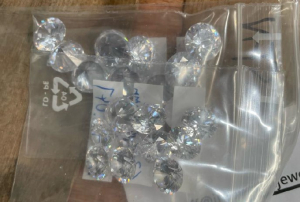Misuse of ATA carnets: overview of Operation JUBILARIAN II
22 February 2024
By the Australian Border ForceHow Operation JUBILARIAN II came about
In 2017, the Australian Border Force (ABF) conducted a project that identified a group of overseas jewellery merchants whose business model involved suspected repeated exploitation of the ATA[1] carnet. The ATA carnet is an international Customs document that permits duty-free and tax-free temporary admission of certain goods to countries that are part of the ATA carnet system for up to one year; including commercial samples, trade fair or exhibition goods and professional equipment.
This project became a catalyst for a WCO-endorsed Operation, called JUBILARIAN, whose first edition was conducted in 2019 – 2020. The objective was for participants to identify the misuse of ATA carnets for the importation of jewellery and precious gemstones and to share their experiences and lessons learnt with each other.
39 Customs administrations joined the ABF-led Operation. The Operation highlighted vulnerabilities in the carnet system. Four of the five high-risk entities identified by the ABF (being regular users of ATA carnets to import jewellery and gemstones into Australia) were found to be misusing the carnet system to evade revenue.
Following the conclusion of JUBILARIAN, the ABF continued to monitor and disrupt the misuse of ATA carnets for the importation of jewellery into Australia, to identify the potential extent of revenue evasion through the carnet system.
Establishing Operation JUBILARIAN II
In 2022, the ABF proposed the conducting of another Operation on the misuse of ATA carnets to the WCO. This proposal was warmly welcomed, and endorsed at the 43rd Enforcement Committee in March 2023.
46 WCO Members participated in JUBILARIAN II from July to October 2023. The Operation had an expanded scope of intent (in comparison to the former), including to:
- identify revenue fraud and potential trade-based money laundering (TBML) specifically involving the importation of jewellery and precious gemstones through the ATA carnet system,
- enhance the global conversation on revenue leakage,
- formulate a strategy to enable an appropriate enforcement response to operational activity.
The ABF conducted rigorous assessments on more than 100 high-risk jewellery carnets, commencing in October 2022, resulting in the selection of 13 high-risk entities for targeting during Operation JUBILARIAN II.

Preliminary findings
Operation JUBILARIAN II identified a number of methodologies employed by criminal groups utilizing ATA carnets to evade revenue, including:
- Phoenix activity – phoenix activity occurs when a director creates a new company to continue the business of a company that has been liquidated, or otherwise abandoned, to avoid paying outstanding debts;
- Possible false declaration of origin noted on carnet at the time of issue;
- Significant funds being transferred out of Australia electronically by foreign representatives with established Australian bank accounts in their personal names, prior to their departure, possibly in an attempt to avoid detection and declaration under Australia’s Anti-Money Laundering and Counter-Terrorism Financing Act 2006;
- ATA carnet holders sending consignments of jewellery items through the cargo stream and making false declarations regarding value and goods description to avoid payment of revenue;
- In addition to jewellery imported under carnets, additional undeclared jewellery items being carried by representatives entering Australia, attempting to avoid payment of revenue, and potentially selling the carnet jewellery in breach of carnet conditions.
During the Operation, the ABF progressed three claims through the National Guarantee Organisation to recover short paid import duties and taxes to the amount of AUD $130,000. These claims are indicative of widespread misuse, and highlight the difficulty Customs authorities have in detecting such fraudulent use, particularly in the airport environment.
Enforcement challenges in the ATA carnet environment
Operation JUBILARIAN II highlighted that carnet exploitation is almost certainly enabled by high-tempo operating environments such as airports, defined by increasing passenger numbers and the challenges in conducting thorough examinations within compressed timeframes and competing priorities.
Conducting in-depth examinations of passengers and their luggage is difficult in the operational environment.
Customs officers must match and verify carnet consignments on a line-by-line level. When Customs officers are presented with carnet jewellery items, their role is to confirm that the goods being presented are those described on the carnet general list. Without adequate professional jewellery expertise or technology, it is difficult for Customs officials to verify authenticity of jewellery before endorsing the import voucher and counterfoil. The same challenge occurs when goods are presented for export endorsement. It is difficult for Customs officials to verify the authenticity of the jewellery, or to confirm that the goods being presented for export are the same goods that were presented at the time of importation, prior to endorsing the export voucher and counterfoil.
 Moreover, most authorized representatives of ATA jewellery carnets generally have more than 500 different lines of jewellery itemized. Controls place an additional burden on operational resources particularly when a non-compliant carnet contains insufficient detail to distinguish one item from another and, in such quantity that, taken as a whole, they no longer constitute samples as per the definition of ‘samples’ in the International Convention to Facilitate the Importation of Commercial Samples and Advertising Material (Geneva, 7 November 1952).
Moreover, most authorized representatives of ATA jewellery carnets generally have more than 500 different lines of jewellery itemized. Controls place an additional burden on operational resources particularly when a non-compliant carnet contains insufficient detail to distinguish one item from another and, in such quantity that, taken as a whole, they no longer constitute samples as per the definition of ‘samples’ in the International Convention to Facilitate the Importation of Commercial Samples and Advertising Material (Geneva, 7 November 1952).
Many Customs officers are further challenged by their limited exposure to ATA carnets and the carnet system’s vulnerability to abuse. When a traveller declares their carnet goods on arrival, Customs officers may not be familiar with the carnet document or the examination procedures to establish elements of non-compliance.
Last but not least, carnet legislation is not only complex, but also varies from one country to another. Issuing authorities in each country have different criteria for eligibility, despite specific guidance in the relevant conventions. This proves a challenge when it comes to eligibility of carnet goods in other countries and territories. During Operation JUBILARIAN II, the question of what quantity constituted a ‘sample’ of jewellery items was raised amongst participants. As an example, although an ATA carnet may be issued for 900 pieces of jewellery articles as samples, the Customs authority of the importing country may consider that number of items too many to be considered a sample, and maintain that a reasonable sample size should consist of 150 articles. Another country may accept 25 articles as a reasonable sample size, whilst yet another may consider only five articles as an adequate quantity for a sample.
Knowledge sharing is invaluable
In response to WCO Members’ requests to enhance their capacity to combat the problem of commercial fraud, the WCO has produced a number of technical materials and guidance documents[2].
In addition, a group was established on the CENcomm, the WCO web-based communication system, with the aim of enabling WCO Members to share experiences, best practices and studies on national and international operational cases. This approach enhances the global conversation relating to revenue leakage and enables administrations to have access to current information, promoting swift action where necessary on emerging fraud methodologies.
The CENcomm group called GTEN – JUBILARIAN II was the primary means of facilitation for Operations JUBILARIAN and JUBILARIAN II, and enabled global information sharing among participants. Members that have participated in the Operations can continue directly exchanging information using the CENcomm group for as long as it is available.
Effective risk management ensures that Customs administrations deploy resources cost-effectively, and cooperation amongst partner agencies will increase the effectiveness of trade enforcement by ensuring all administrations involved are identifying and collecting all legally due revenue.
More information
For more information, or carnet enquiries and referrals, please contact the ABF National Temporary Imports and Securities Team – ntis@abf.gov.au
[1]ATA is an acronym of the French and English terms “Admission Temporaire/Temporary Admission”. The ATA carnet is established under the Customs Convention on the ATA carnet for the temporary admission of goods (ATA Convention) and the Convention on Temporary Admission (Istanbul, 26 June 1990). More information: https://www.wcoomd.org/en/topics/facilitation/instrument-and-tools/conventions/pf_ata_system_conven.aspx.
[2]https://www.wcoomd.org/en/topics/enforcement-and-compliance/activities-and-programmes/revenue-programme.aspx


